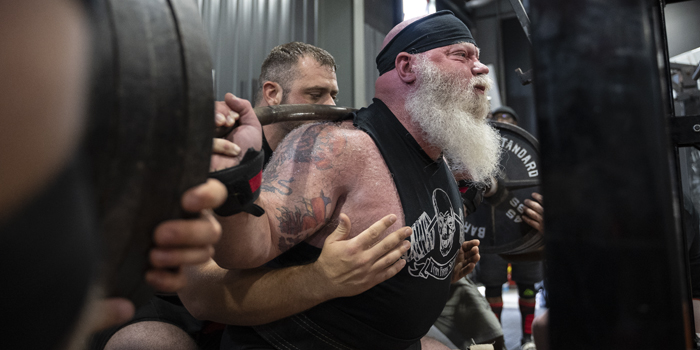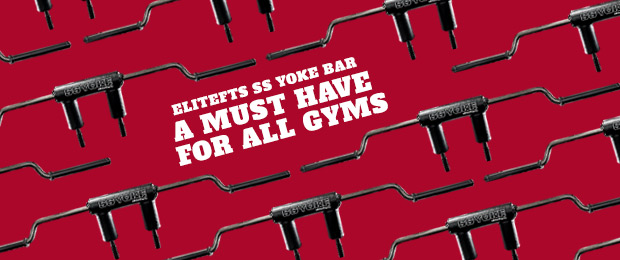
The decision to go back to school was made from necessity. My body was a mess—I was coming off a ruptured patellar tendon, two high-grade pec muscle belly tears, and a torn left triceps tendon (not to mention the boatload of injuries I accumulated from motocross before powerlifting). If I wanted to continue with powerlifting at a high level AND reach higher levels, I needed to figure out my shit. So, after weighing out the options of different chiropractic schools and their proximity to powerlifting gyms, we packed up the car and made the 40-something hour drive from Calgary, Alberta, to Daytona Beach, Florida.
At first, I thought I was getting hurt because I was doing too much. It made sense in my head, and it's what most of the people around me were saying. Train balls to the wall, push hard, push beyond what you should be doing, and stuff is bound to break, right? Back things off, do a little less, don't push as hard, and my recovery capabilities wouldn't be as taxed, right? Well, I wasn't entirely wrong, but I wasn't entirely right either.
RECENT: Technique's Role in Injury Risk
Most of how I shifted my training was by being stupid in the gym. I stopped max effort work to the point of gnarly misses. I stopped loading my dynamic work to the point that it was borderline max effort. To supplement that strategy, I attempted to reduce the stress placed on my previous injuries. I adjusted technique and exercise selection to avoid loading the areas I was experiencing pain. Lastly, I greatly reduced my total training volume and frequency.
The thought was that if I stopped pushing what was getting hurt, it would stop breaking and it kind of worked. From 2019 through 2020, I put pounds on both my raw and equipped totals, and I didn't have any major blowouts. Problems still existed, but I didn't experience any major tears. Instead, I started to accumulate these little dings and tweaks on sets where they really shouldn't have happened.
What Was Going On?
Looking at why acute musculotendinous injuries (strains, tweaks, tears, and ruptures) happen, it boils down to the tissues being stressed more than they are prepared to handle (Arnason, 2014). That can be a matter of absolute load (you put too much weight on the bar) or cumulative load (you accumulated more volume than you were able to recover from). It should also be noted that injury is multifactorial, meaning that outside factors can influence a tissue's tolerance to load (Gabbet, 2020).
We can look at the relationship between loading and tissue tolerance from a couple of directions. First, consider the amount of load placed onto muscles and tendons. Second, consider the muscle or tendon's tolerance to being loaded. We can reduce the amount of load placed on tissue to reduce the likelihood of injury. We can also work to increase a tissue's tolerance to loading—with my previous strategy, this is what I was missing.
With my strategy of doing less, I effectively reduced the demand placed on my tissues below the threshold that would cause a large tear or rupture. Like I mentioned above, at first, it worked great—I stopped having big injuries. But as time went on, I wasn't doing enough to maintain my tissue's readiness to handle the demands of training. Then, I began to have those annoying little tweaks. At least that is the framework of my current theory.
Strength Training Can Be Protective Against Injury
Wait, what? Isn't this an article about how I kept getting hurt while strength training?
There is a paradox surrounding strength training and injury (Gabbet, 2016). Strength training has been shown to have the potential to be both causative of and protective against injury. How can that be?
When we think about this in terms of traditional sport, it makes complete sense: A stronger athlete is better prepared to handle the demands of the court or field if their training is not taking away from what they are doing on the court or field and the athlete is prepared to train hard. The training/injury paradox comes down to questioning whether an athlete is ready to handle the training loads they will be exposed to and if those training loads are in the sweet spot that will elevate their on-field performance. If an athlete is underprepared for their training, volume and intensity should slowly be ramped up to bridge the gap to that sweet spot rather than making a sudden leap in workload.
But what happens when the sport essentially is strength training, and the field is a platform with a barbell on it?
In traditional sport, almost everything an athlete does in the gym is general in that it won't have much direct skill translation to the field. Practice is there to elevate skill, improve coordination at play, and replicate competition elements. For traditional sport, strength training builds the athletes up to do more with the skill they already have both in practice and competition.
Powerlifting's field is a squat, bench, and deadlift done in a meet. Our practice can be seen as the squatting, benching, deadlifting, and their close variations—the movements specific to the platform, with direct skill translation, and with direct correlations to our competitive performances.
For powerlifters, accessory work plays a role equivalent to that of training in traditional sport. Our accessory work builds us up and elevates our main work capacity. Our accessory work should prepare us to handle more of our main work and reach higher levels on the platform. The better conditioned our tissues are to work, the more work they'll be able to handle. A dumbbell fly may not directly improve your bench, but it can bring up your pecs, allowing you to handle more volume and intensity in your press training. Handle more volume and intensity over time, and you will get stronger.
Suppose we want to work towards protecting ourselves from injury. In that case, we need to look deeper at the role our accessory work plays and make sure that we are performing our accessory work in a way that supplements our competitive movements. That means that if we want accessory work to have a protective influence against injury, we need to train our accessories hard enough to raise our capacity under the bar.
Muscular Strength VS. Mechanical Strength
I was introduced to the concepts of muscular strength and mechanical strength years ago in a second-year biomechanics presentation chalked full of stress/strain ratio graphs. At the time, I didn't think too much of it. The importance of the distinction between the two attributes and their implications on training wasn't driven home until I read a blog post written by Dan Van Zandt of Flexibility Research on the topic.
Muscular strength refers to the ability of the musculotendinous unit to actively produce force. Think, "how hard can a muscle contract." Whereas mechanical strength refers to the ability of the musculotendinous unit to absorb forces before failure. Think "how hard can I strain before something snaps."
With muscular strength and mechanical strength being different attributes, they are best trained differently. We're powerlifters here. When it comes to muscular strength, we already know that lifting heavy weights for low repetitions is how you get stronger. Interestingly, mechanical strength isn't as often talked about. Muscular endurance style training with lower loads for higher repetitions (15+) is how the mechanical tolerance of muscles, tendons, and connective tissues is best brought up (Tipton et al., 1975).
The take-home here is to increase our ability to lift heavier and heavier weights by lifting heavy weights. We can increase our tolerance to lifting heavier weights by lifting lighter weights for a lot of reps.
How Can We Better Set Up Our Training?
The vast majority of injury risk reduction will come down to load management. Don't be a dumbass with your main work. Don't push harder than you need to or are prepared to. At the same time, we need to find a way to push hard enough to drive progress.
So, take your accessory work seriously and use it to raise your capacity. Spend time in higher rep ranges to elevate your connective tissue's tolerance. Instead of avoiding problem movements or body parts completely, find ways to train them and bring them up. Before you begin a meet prep, make sure that you are in good enough shape to train hard.
Since beginning to implement these new changes to my training in early 2021, I have been able to handle all-time high levels of total volume, haven't had a strain or tweak in over a year, and my body feels better than it ever has in the gym and on the platform.
References
- Arnason, A. (2014). The Role of Musculoskeletal Fitness in Injury Prevention in Sport. In C. Liebenson (Eds). Functional Training Handbook (1st ed., pp. 5-17). Wolters Kluwer Health.
- Gabbett, T.J. (2016). The training—injury prevention paradox: should athletes be training smarter and harder? British Journal of Sports Medicine vol. 50, pp. 273-280.
- Gabbett, T.J. (2020). Debunking the myths about training load, injury and performance: empirical evidence, hot topics and recommendations for practitioners. British Journal of Sports Medicine vol 54, pp. 58-66.
- Tipton, C. M., Matthes, R. D., Maynard, J. A., & Carey, R. A. (1975) The Influence of Physical Activity on Ligaments and Tendons. Medicine and Science in Sports vol. 7, no. 3, pp. 165-175.

Seth Albersworth is a powerlifter with experience in and out of gear. His best totals are 2105 pounds raw and 2408 pounds multi-ply. Seth has completed his bachelor's degree in kinesiology from the University of Calgary and recently graduated from Palmer College of Chiropractic's Florida Campus. He's in the process of acquiring licensure as a Doctor of Chiropractic.










1 Comment